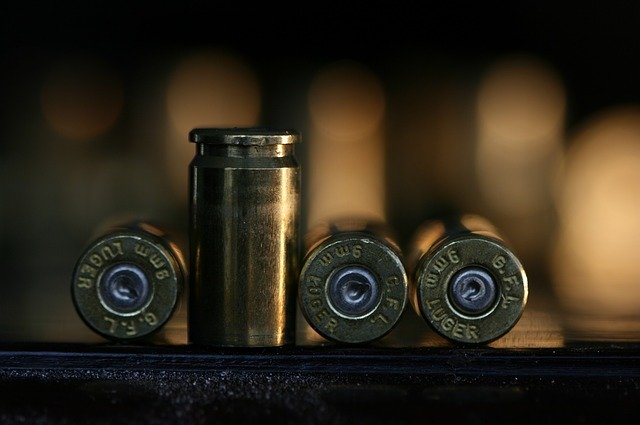Gun violence in America
In 2019, there has been more than one shooting for every day of the year, and the year isn’t over yet.
There have been 392 shootings this year, according to the Gun Violence Archive, (GVA), a nonprofit that records gun violence in America. Here, gun violence is frequently talked about due to mass shootings in the media and gun control talk in politics.
With the increasing presence of shootings in media and the candidates for the upcoming election talking about the second amendment, it seems there is no escape. Despite the increased presence in the media, shootings are not getting more frequent, and there is no pattern in the last five years of mass shootings, as shown on the GVA’s charts for each year. However, from 2014 to 2017, there was an increase in the number of gun-related incidents. These include defense shootings, police incidents and suicides. In 2019, the number of mass shootings has been the highest since the GVA started its count in 2014.
So what is being done about gun incidents? In the ICCSD, students with firearms at school will be expelled for no less than one year. If a student is caught with a weapon, the weapon is confiscated and given to the police, and disciplinary action will be taken based on the type of weapon and what was done with it. However, students are more likely to bring a knife or sharp object to a school than a gun.
West High has been renovated, locking the doors and allowing entry only with a student ID to increase overall security. Carmen Crabtree ’22 is unsure how effective these improvements are.
“What if [the shooter] is a student with an ID? They can walk in,” Crabtree said.
Some schools across the country in states like Missouri and Illinois have decided to arm teachers and train them to take action against active-shooters. Lawmakers and politicians in multiple states including our president have backed these schools in their actions, while others are conflicted. There is a concern that putting a gun in the school in the first place could lead to more problems. It is an ethical question of giving teachers a lethal weapon and how much training they will receive.
West High does not currently have armed teachers or a student resource officer (SRO) on the premises, although the possibility of an SRO is being discussed by school board members. SROs are armed officers for the school with the intention of handling student conflicts and preventing incidents like shootings. Olivia Barker ‘20, a student involved in Students Against School Shootings, is not in favor of an SRO.
“Having school resource officers in school may have minor benefits, but the risk is too high. School resource officers pose a threat to students of color and students with disabilities who are at a higher risk than white students of being victims of police violence,” Barker said.
Some students, however, are for SROs because they might help control the student body.
“I think [an SRO] would be good. There’s a lot of fights and a lot of people stealing stuff,” says Crabtree.
Not all teachers agree with these policies either. English teacher Katy Nahra grew up with an SRO.
“It was fine, it didn’t create a fearful atmosphere or anything,” Nahra said.
Despite her positive experience, she wonders if the money and resources put into having an SRO would be better used elsewhere. Nahra is very against having an armed teacher.
“It’s ridiculous. At some point, you have to choose. Did you sign up to be a law enforcement officer or a teacher? And we don’t want to confuse the two …. I don’t feel that we are trained, even if we were ‘trained’, that is not our job,” Nahra said.
According to Gun Violence Statistics, on average fewer people die from gun-related deaths in states with tighter gun control laws. However, tighter gun laws lead to Americans questioning if their second amendment rights are being violated. Politicians and civilians alike are conflicted when faced with the question of gun control vs. losing gun rights.
Gun control comes in many different forms depending on the state. There have been restrictions on the types of guns sold, and certain things like silencers, a piece of technology that quiets the sound of a gunshot, are being made illegal for most gun models and civilians. Establishments have the right to prohibit weapons on their property, just as they can require customers to wear shirts and shoes. Depending on the state, civilians can apply for a concealed carry license. Iowa is one of these states. States have a considerable amount of options when setting their own laws. They can require or not require licenses and permits for types of carrying and types of guns.
Most people agree that not everyone should possess a weapon. Many gun incidents are blamed on mental illness. Some people are not mentally stable enough to possess a weapon. Those who are mentally unstable are not dangerous, but mental illness treatment can prevent gun violence.
A proposed solution to this is more extensive background checks on people with relevant illnesses and past offenses. Coworkers, fellow students, and teachers can be trained to look for behavioral signs that can be used as ‘warnings’ for future violence, such as what people post on social media. The Parkland Florida shooter had made threatening comments and referenced guns on his social media accounts. He had been flagged by the FBI but was still able to legally purchase a gun. This is an example of how background checks can be used to prevent these situations.
Guns are an institution that is not going away in America, but gun violence can be prevented and lessened. Young people are becoming more involved with problems such as violence, hoping to make a difference.
“The solution to gun violence is gun control. Young people must step up and vote for politicians who will push gun control legislation. We have to close the loopholes that allow domestic abusers to buy guns and the government should enact a buy-back program that would help to decrease the number of guns in circulation,” says Barker.
The school takes input on safety from students, parents, and teachers.
“I would like to know what the students think,” says Nahra, “Because that’s what it’s all about. To make them feel safe.”
National Domestic Violence hotline: 1-800-799-7233
Your donation will support the student journalists of West High School. Your contribution will allow us to purchase Scholarship Yearbooks, newsroom equipment and cover our annual website hosting costs.

(she/her) Maddy Smith is a senior at West. This will be her third year on staff. She is the online Features and Visuals editor. She enjoys music, photography,...



